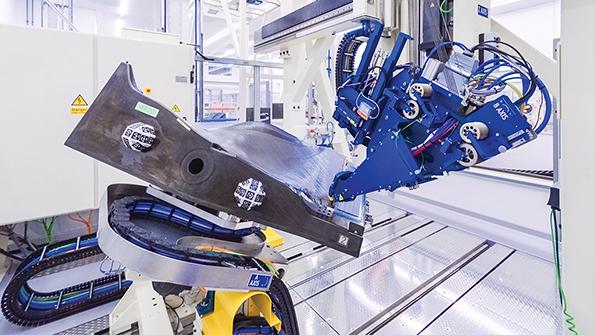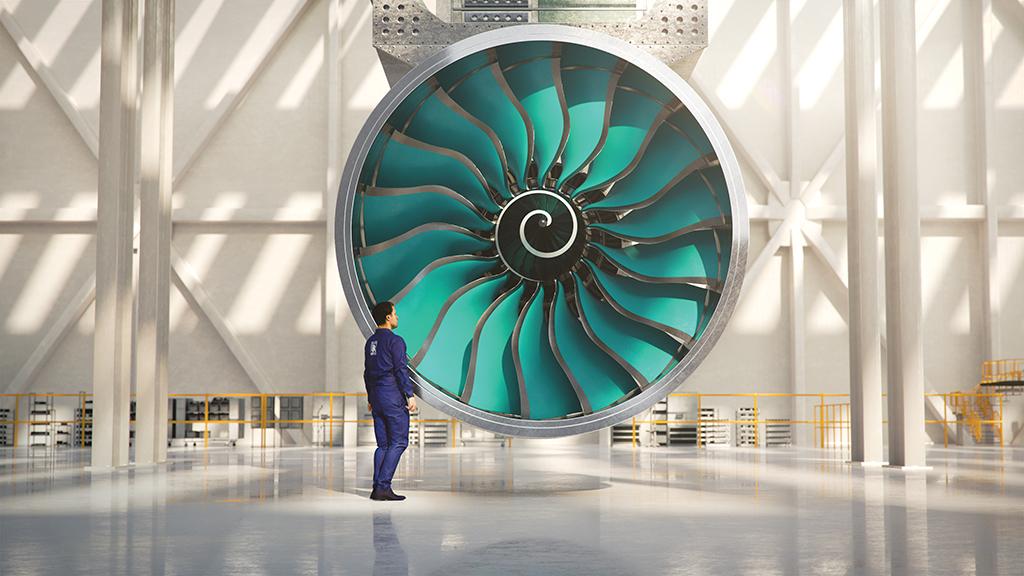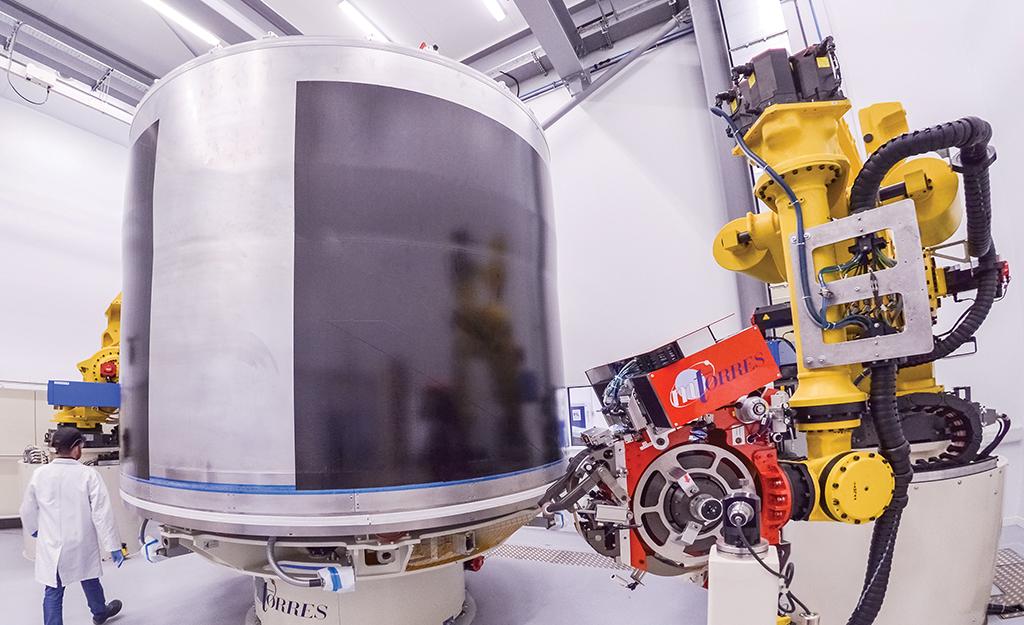
Six-and-a-half years after Rolls-Royce revealed radical plans to develop a next-generation geared engine called the UltraFan, the company is starting to build up modules for the first demonstrator.
Rated at 84,000-lb. thrust and with a 140-in.-dia. composite fan, the engine’s new core and geared drive mark a departure from the three-shaft architecture that has formed the basis of the company’s big-fan family since the 1970s. The engine is scheduled to begin ground tests in 2021, with follow-on units joining the test effort in 2022 and paving the way for initial production versions later in the decade.
- Composite fan and case for demonstrator in final assembly
- ITP completes first intermediate-pressure turbine case
The engine size for those initial applications remains unknown, but lies within the 25,000-100,000-lb.-thrust range covered by the scalable UltraFan architecture. Having seen the first potential application, the New Midmarket Airplane, disappear with Boeing’s product strategy rethink, Rolls remains agnostic on initial candidate applications.
The collapse in global air transport triggered by the COVID-19 pandemic may give Rolls more time to refine its initial offering as Airbus and Boeing pause their product-development planning. “We are keen to get through the technology de-risking stage . . . so having a little more time to reflect on that might be beneficial,” says Andy Geer, chief engineer and UltraFan program head.
“But the world doesn’t stand still. Depending on the rate at which the business recovers and to what extent the fuel price goes back to where it was—or starts to attract carbon taxation—all of those factors could affect the dynamics of the market quite quickly. We just have to be in a position to be ready for when that long-term market recovery comes along,” Geer says. “It is still the purpose of the demonstrator to be ready for whenever the customer airlines and airframers converge their strategic needs.”
Rolls believes nothing has changed to fundamentally alter either the goal of the UltraFan demonstrator or the long-term prospects for the engine. “It’s scalable and then you have choices,” says Geer. “Once you have demonstrated the capability, you have choice. And beyond that, you have credibility when you offer those choices. The goal is to get these technologies ready to use. The exact way we use them—the mix—we can adapt that once you have credibility of the technology set.”
To get to the demonstrator, Rolls has focused on two main tracks: improving thermal efficiency by building the hotter, smaller core of the Advance3 test engine; and enhancing propulsive efficiency by developing new low-pressure (LP) system components to increase bypass ratio with a bigger, slower fan.

While the Advance3 core could form the heart of a future direct-drive turbofan, it also paves the way for the geared UltraFan. The new core reduces the workload on the intermediate-pressure (IP) compressor while increasing the workload on the high-pressure (HP) compressor.
The UltraFan’s new LP architecture builds on this by introducing a bigger IP turbine that is used to drive the IP compressor and fan via a gearbox. By linking the fan to the high-speed IP turbine instead of driving it directly with the LP turbine, as in Rolls’ current Trent engines, the UltraFan eliminates this large latter turbine section, making underwing installation easier.
The first large components for the demonstrator engine are coming together. Initial composite fan blades are in assembly following ground and flight tests under the Advanced Low Pressure System program. Developed in partnership with industry, the European Clean Sky and UK government Innovate programs, the blade set and composite fan case will save around 1,500 lb. per shipset on a twin-engine aircraft compared to a metallic design.
“Having a low-speed fan is essential when you move to such a high bypass ratio, so for this it involves both low-speed aerodynamics and carbon-titanium construction,” says Geer. Building on ground and flight testing at Trent 1000 scale, plus component tests at UltraFan scale, the company has completed the first fan case. Further tests at UltraFan scale are planned in a trailing-blade impact rig in 2021.

Testing of the power gearbox in Dahlewitz, Germany, has been underway since the end of 2019 with the eighth build-standard of engine-representative hardware. The system consists of a ring gear enclosing five planetary gears that rotate around a central sun gear. The fan drives off a centrally mounted planet carrier.
The baseline gearbox design has been tested in a special attitude rig since 2016 and in a power rig since 2017. “We have a number of other units in build which will continue testing through 2021 to take it to maturity. Basic characterization is now complete, and we are happy with that,” says Geer.
Advance3 demonstrator tests have meanwhile passed the 100-hr. mark, including full-power runs. The advanced core is integrated with a Trent 1000 LP turbine and Trent XWB-84 fan system to demonstrate new features including a low-emissions lean-burn combustor and additively manufactured components.
The rebuilt engine will return to test this year for a second phase that is scheduled to continue through 2021. The first phase characterized the core’s basic behavior under relatively controlled operating conditions. “Now we get to push it into more extreme circumstances it would see in operation,” says Geer.
In parallel with testing under Advance3, the lean-burn design is being evaluated under the Advanced Low Emissions Combustor System program. Reducing emissions by combusting fuel more efficiently through a series of concentric burners, the design has completed ground tests in a modified Trent 1000. A further phase of ground and flight tests is to start shortly, according to Geer.
A better combustion system also is expected to maximize turbine capability and help improve cycle efficiency in the UltraFan. The exit conditions of the combustor play a significant role in the efficiency of the HP turbine. “If you can design your combustor to provide the best possible temperature profile entry conditions to the turbine, that helps the engine system,” he says.
Another area of testing is focused on the aerodynamics and mechanics of the UltraFan’s lightweight four-stage IP turbine. Developed with Rolls’ Spanish subsidiary ITP Aero, the nickel alloy turbine section has completed aerodynamic evaluation on a rig at the CTA Aerospace Test Laboratory near Barcelona. ITP has manufactured the first IP turbine case for the demonstrator.
“We are moving quickly through the design release and manufacturing of components across the whole of the UltraFan demonstrator engine,” reports Geer. “It’s a busy time, and it’s not ideal that we happen to be doing this on the back of the COVID-19 pandemic. Inevitably, it’s a bit of hard work at the moment with the world supply chain being disrupted.”
Despite this, the demonstrator remains on track to start tests in 2021. “We’ve had hits as a result of COVID and are seeing a range of challenges,” he says. “If we only need a single part in a module, but it has been impacted by a supply-chain disruption, then it causes us to wait to launch that module. It’s been a little bit hand-to-mouth in how that works out in today’s world.”

